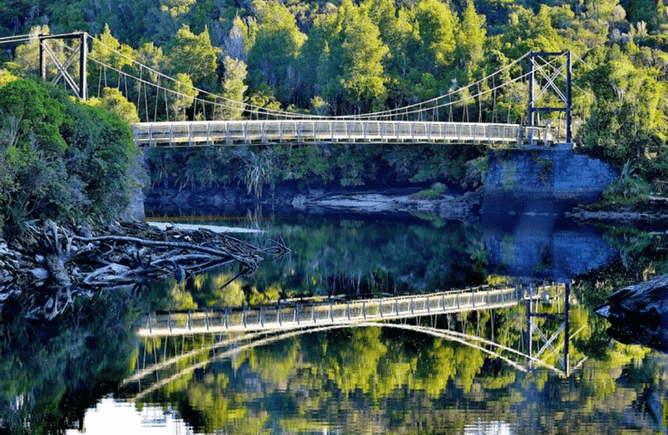Ōkari Lagoon to Tōtara River – Between Forest and Sea
Every time we begin this section of the Kawatiri Coastal Trail, we feel as though we are entering a quieter world. The air around Ōkari Lagoon is soft and still, touched only by the distant cry of a heron or the faint movement of reeds in the breeze. It is the perfect place to start the day slowly, with a deep breath and a moment to listen before setting off.
Leaving the lagoon, the trail follows the edge of the wetlands for a while before curving inland. The path winds gently through coastal scrub, past stands of manuka and flax that glisten with dew in the morning light. Sometimes we stop just to listen to the sounds around us. A bellbird might call from somewhere unseen, or the rustle of a weka in the undergrowth might make us smile. This is the West Coast at its most peaceful, and we always find ourselves slowing our pace to match its rhythm.
Before long, the landscape begins to change again. The coastal flats rise into low forested hills, and the scent of damp earth and tree fern replaces the salt of the sea. We cross small wooden bridges over streams that weave down from the Paparoa foothills. Every turn reveals another view that feels both ancient and alive. We love this variety — one moment surrounded by open sky and wetland birds, the next enclosed by tall trees and the quiet hum of the forest.
Halfway along, the trail passes through an area of native bush that feels almost untouched. The canopy above is thick and green, and shafts of sunlight filter through to light the path. Sometimes we meet other riders or walkers here, but often we are completely alone. It is a place that encourages reflection. The forest seems to absorb sound, leaving only the rustle of leaves and the occasional call of a tui echoing above.
Crossing the new suspension bridge over the Ōkari River is always a highlight. The view from the middle of the bridge is breathtaking. Upstream the river twists through a deep green valley, and downstream it opens toward the sea. The water moves slowly, reflecting the sky and the trees like a mirror. We often stop here for photos or simply to watch the current glide beneath our feet. There is something deeply soothing about that view.
After the bridge the trail climbs slightly and follows a ridge that looks out toward the inland ranges. On clear days we can see as far as the high peaks beyond Charleston. The sense of space is immense. When we ride this section later in the afternoon, the light turns golden and filters through the trees in long bands, giving the forest a soft, glowing quality. It feels as if the whole world has slowed down.
Approaching the Tōtara River, the air cools again and the trees begin to thin. The sound of running water grows louder until finally the river itself appears, broad and quiet beneath the trees. We like to sit by the bank for a while before turning back. The water is crystal clear, and the stones at the bottom shine in muted shades of gold and grey. Sometimes we spot a kingfisher darting across the surface or a pair of paradise ducks drifting downstream.
This is one of those parts of the trail that rewards anyone who takes their time. It is not dramatic like the cliffs at Cape Foulwind, but it has a beauty that feels deeper and more personal. The forest wraps around you like a protective cloak, and the river moves with a steady rhythm that seems to slow your thoughts. We always finish this section feeling calm, restored, and grateful for the quiet generosity of this landscape.
When we return home in the evening, the scent of the forest still clings to us. We pour a glass of wine, sink into the hot tub, and watch the light fade behind the hills. The memory of the trail stays with us long after the day is done.


